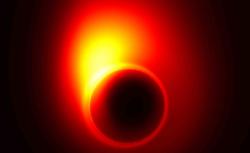Black holes are fascinating and mysterious, but they’re hard to study. Not only are they black—nothing can escape them, including light—they’re unfathomably distant. But by linking a network of radio telescopes around the country, a team of astronomers has glimpsed for the first time the environment immediately surrounding a supermassive black hole at the center of the M87 galaxy, more than 50 million light years away.
Specifically, they were able to estimate the size of the base of a galaxy-long plasma jet that shoots out from the hole on either side. It was smaller than anticipated, which suggests the black hole is spinning with incredible velocity—and that the giant ring of superheated debris whirling around it, called an accretion disc, is spinning in the same direction.
The findings were published online Thursday in the journal Science. They lend empirical support to a theoretical model of how black holes generate those plasma beams, called relativistic jets.
Researchers in the past have studied the black hole at the center of our own galaxy, the Milky Way, explains Shep Doeleman, assistant director of MIT’s Haystack observatory and lead author of the study. But that one is apparently a bit of a weakling as far as black holes go, with a mass just 4 million times that of the sun, and it doesn’t appear to produce these polar jets. The black hole at the center of M87 is 6.5 billion times the mass of the sun, and its plasma beams are marvelous.

Avery E. Broderick (Perimeter Institute & University of Waterloo)
“This is the first time we’ve gotten this close of a look at any jet issuing from a black hole,” Doeleman tells me. “So how these jets are formed has been a mystery. The best work has been simulations on supercomputers, which produce beautiful pictures of what jets should look like very close to a black hole.” But by combining telescopes in California, Arizona, and Hawaii into essentially one huge telescope, called the Event Horizon Telescope, Doeleman’s team was able to begin piecing together a picture of what they actually look like.
In the future, the plan is to further refine that picture by expanding the Event Horizon Telescope to include other telescopes around the world. The findings reported in Science this week are “just the tip of the iceberg,” Doeleman says.

NASA and Ann Field (Space Telescope Science Institute)
